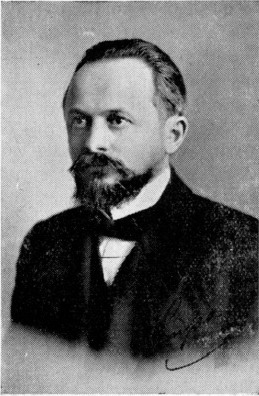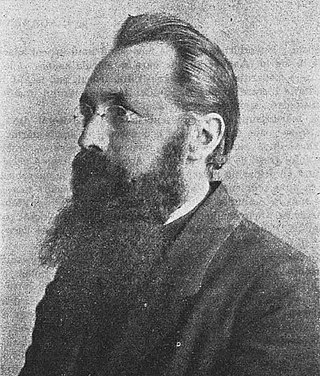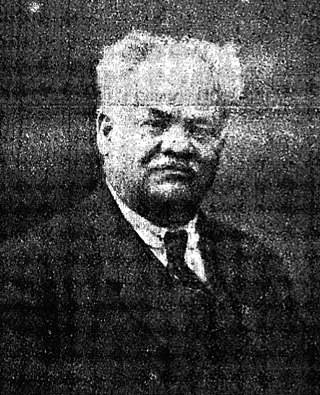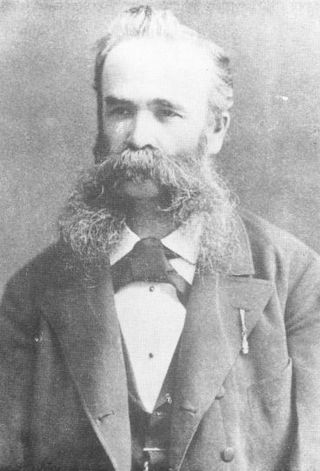
The Romanian Orthodox Church, or Patriarchate of Romania, is an autocephalous Eastern Orthodox church in full communion with other Eastern Orthodox Christian churches, and one of the nine patriarchates in the Eastern Orthodox Church. Since 1925, the church's Primate has borne the title of Patriarch. Its jurisdiction covers the territories of Romania and Moldova, with additional dioceses for Romanians living in nearby Serbia and Hungary, as well as for diaspora communities in Central and Western Europe, North America and Oceania. It is the only autocephalous church within Eastern Orthodoxy to have a Romance language for liturgical use.

Iustin Moisescu was Patriarch of the Romanian Orthodox Church from 1977 to 1986.

Ioan Lupaș was a Romanian historian, academic, politician, Orthodox theologian and priest. He was a member of the Romanian Academy.

Octavian or Octav Smigelschi was an Austro-Hungarian painter and printmaker, one of the leading culturally Romanian artists in his native Transylvania. Of mixed Polish, Aromanian, and possibly Ruthenian, background, he identified mainly with the Romanian-speaking Greek-Catholics, although some of his most important work was also done for the rival Romanian Orthodox Church. Smigelschi studied under Bertalan Székely at the Drawing School and Art Teachers' College in Budapest, becoming familiar with the historicist trend in contemporary Hungarian art. While working on and off at high schools in Upper Hungary and Transylvania, he experimented with borrowings from ancient Romanian handicrafts. Smigelschi's European journeys with Arthur Coulin took him to Cervara di Roma, where he studied Renaissance art, while moving away from academic art and into Symbolism and Art Nouveau.

Nicolae Bălan was an Austro-Hungarian-born Romanian cleric, a metropolitan bishop of the Romanian Orthodox Church. The son of a priest, he graduated from Czernowitz University and taught theology at Sibiu from 1905 to 1920. That year, he became Metropolitan of Transylvania, an office he would hold for the rest of his life. In the 1930s, he was an open supporter of the Iron Guard. In 1942, during the Holocaust, he intervened in Bucharest against the planned deportation of Romanian Jews from the Regat, Southern Transylvania and the Banat to the Nazi extermination camps. In 1948, after a communist regime was established, he publicly assisted the new authorities in their effort to disband the Romanian Greek-Catholic Church.

Ion Agârbiceanu was an Austro-Hungarian-born Romanian writer, journalist, politician, theologian and Greek-Catholic priest. Born among the Romanian peasant class of Transylvania, he was originally an Orthodox, but chose to embrace Eastern Catholicism. Assisted by the Catholic congregation of Blaj, he graduated from Budapest University, after which he was ordained. Agârbiceanu was initially assigned to a parish in the Apuseni Mountains, which form the backdrop to much of his fiction. Before 1910, Agârbiceanu had achieved literary fame in both Transylvania and the Kingdom of Romania, affiliating with ASTRA cultural society in 1912; his work was disputed between the rival schools of Sămănătorul and Poporanism. After a debut in poetry, he became a highly prolific author of novels, novellas, and other forms of prose, being rated as "Chekhovian" or "Tolstoyan" for his talents in describing the discreet suffering of common folk.
Romulus Cândea was an Austro-Hungarian-born Romanian ecclesiastical historian.

Gheorghe Bogdan-Duică was an Imperial Austrian-born Romanian literary critic. The son of a poor merchant family from Brașov, he attended several universities before launching a career as a critic, first in his native town and then in Czernowitz. Eventually settling in Bucharest, capital of the Romanian Old Kingdom, he managed to earn a university degree before teaching at a succession of high schools. Meanwhile, he continued publishing literary studies as well as intensifying an ardently nationalistic, Pan-Romanian activism. He urged the Romanian government to drop its neutrality policy and enter World War I; once this took place and his adopted home came under German occupation, he found himself arrested and deported to Bulgaria. After the war's conclusion and the union of Transylvania with Romania, he became a literature professor at the newly founded Cluj University. There, he served as rector in the late 1920s, but found himself increasingly out of touch with modern trends in literature.

Vasile Moga was an Imperial Austrian ethnic Romanian bishop of the Romanian Orthodox Church. A native of Sebeș, he was a parish priest for some years before being made bishop of Transylvania. The first Romanian to hold this office in over a century, he served for over three decades. Living in Sibiu during this period, he worked both to improve the spiritual and educational foundations of the diocese and to secure additional rights for the province's Romanians.

Ioan Mețianu was an Austro-Hungarian cleric of the Romanian Orthodox Church.

Miron Romanul ; September 4 [O.S. August 23] 1828–October 16 [O.S. October 4] 1898) was an Austro-Hungarian cleric of the Romanian Orthodox Church.

Vasile Mangra was an Austro-Hungarian cleric of the Romanian Orthodox Church and historian.

Grigorie Gh. Comșa was an Austro-Hungarian-born Romanian cleric who became a bishop within the Romanian Orthodox Church.

Nicolae Cristea was an Austro-Hungarian ethnic Romanian Orthodox priest, professor, journalist and political activist. A protégé of Andrei Șaguna, he studied in Germany before returning to edit the church's newspaper for nearly two decades, a period during which he also taught at the theological seminary in Sibiu. He was politically active, a stance that culminated in the early 1890s with his signing of the Transylvanian Memorandum and subsequent imprisonment.

Ioan Pușcariu was an Austro-Hungarian ethnic Romanian historian, genealogist and administrator. A native of the Brașov area, he studied law until the 1848 revolution, when he took up arms. After order was restored, he embarked on a four-decade career in government that took him throughout his native Transylvania as well as to Vienna and Budapest. During the 1860s, Pușcariu was involved in the political debates of his province's Romanians, and also helped set up their key cultural organization, the Transylvanian Association for Romanian Literature and the Culture of the Romanian People (ASTRA). His historical interests lay primarily with the Transylvanian Romanians' nobility and their genealogy; Pușcariu's research into the subject secured his election to the Romanian Academy.

Dimitrie Comșa was an Imperial Austrian-born Romanian agronomist and political activist.

Daniil Popovici-Barcianu was an Austro-Hungarian ethnic Romanian teacher, naturalist and political activist.

Nicolae Popea was an Austro-Hungarian ethnic Romanian bishop of the Romanian Orthodox Church, as well as a historian.

Andrei Oțetea was an Austro-Hungarian-born Romanian historian.

Teofil Herineanu was an Austro-Hungarian-born Romanian cleric.




















